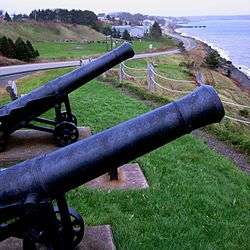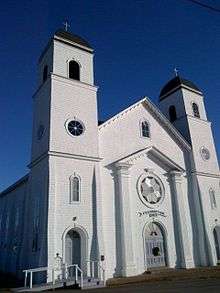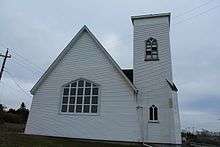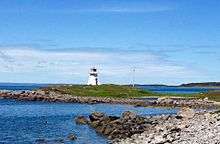Arichat, Nova Scotia
Arichat is a Canadian village in Nova Scotia. It is one of the oldest communities in the province, dating back to the 18th century.
Arichat | |
|---|---|
Village | |
 The island community of Arichat, Isle Madame, Nova Scotia as seen from Cannon Look-Off. These cannons commemorate the eighteenth century period of the community's long history. | |
 Arichat | |
| Coordinates: 45°30′40.17″N 61°0′46.5″W | |
| Country | |
| Province | |
| District | Richmond County |
| Established | 1785 |
| Government | |
| • Type | Village |
| Time zone | UTC-4 (EST) |
| • Summer (DST) | UTC-4 (AST) |
| Postal code span | B0E |
| Area code(s) | 902 |
| Website | http://www.arichat.ca/fr/acceuil.php |

It is a district of Richmond County on Isle Madame and is currently the seat of the Municipality of Richmond County.
Etymology
The Mi'kmaq name "Nerichat" eventually became Arichat. On some early plans it is found as "Nerichau." West Arichat was at one time named Acadiaville, as some of the Acadians after their expulsion from Grand Pre, settled in this area. Indigenous peoples also had the name of "Liksake" for Arichat, meaning worn rocks, also "ehksake" meaning "the camping ground."
History
Arichat is located on what forms a protected natural harbour. As such, it was an important gem in the Acadian colony of New France, along with the contemporary capital of Ile Royale, Louisbourg.
After the British victory in the Seven Years' War, Arichat would be a valuable port in the fishery trade, the entrepreneurs of which were Charles Robin and John Janvrin, amongst others.
During the American Revolution, on 22 September 1776, Canso, Nova Scotia was attacked by American privateer John Paul Jones - the Father of the American Navy. The privateer sailed on USS Providence and destroyed fifteen vessels, and damaged much property on shore. There he recruited men to fill the vacancies created by manning his prizes, burned a British fishing schooner, sank a second, and captured a third besides a shallop which he used as a tender. Jones then pillaged the community of Petit-de-Grat and Arichat and then returned to Boston.
Jerseyman Island
Jerseyman Island protects Arichat harbour, acting as a natural breakwater. Having been used by the local Mi'kmaq for thousands of years. With the arrival of the Europeans to the area in the 1500s, the island would become a haven for the cod fishery, with the first North American branch of the Robin Company being established in 1764. During the American Revolution, the island as well as villages on Isle Madame were attacked by Jones' crew and the stores were pillaged and burned, eventually being rebuilt in Arichat.[1]
The island remains uninhabited to this day, with the lighthouse becoming unmanned in 1978.
LeNoir Forge Museum
The LeNoir Forge was originally built in 1793 by Thomas LeNoir, a native of France. He was a skilled locksmith; however the monetary return for his labor was not as rewarding as hoped and he eventually returned to regular blacksmithing. During this period of history shipbuilding and repair was flourishing on Isle Madame. The forge produced materials that were used in this industry. By the end of the 19th century the heyday of wooden sailing ships was over, business dwindled and the forge eventually fell into disrepair. The Isle Madame Board of Trade took on the sponsorship to restore this stone building as a 1967 centennial and municipal project.[2]
Education
Arichat Seminary School/Beginnings of St. Francis Xavier University
Arichat played an important role in the education of young minds. "At Arichat under the leadership of Right Reverend Colin F. MacKinnon the first classes of Saint Francis Xavier University began on July 20th, 1853.[3] By December of 1853, 12 students were reported to be in residence, with enrollment expected to increase. Students would study a variety of topics, including philosophy, theology and the classics. The majority of students were of Scottish ancestry, and it was noted that the local Acadians for the most part, had minimal enrollment, in part due to materials being covered in English and not in French, the predominant language of the island at the time.
The second year of saw the registration of 15 students by November, 1854 while 40 or more studied other programs offered on the campus, or "the Big House."[4]
The college would move from Arichat to Antigonish, as it was known that the town would only play host to the college temporarily. Bishop MacKinnon had arranged for new facilities to host the school in the late summer of 1855 and hoped to make Antigonish "
Ecclesiastical history
The Catholic Cathedral of Notre Dame de l'Assomption was first constructed in 1835, with its first Mass being celebrated in 1837. The original building was destroyed and rebuilt. In 1894, it underwent significant structural changes, seeing the lone steeple being replaced with the two towers and two story stained glass windows which have become symbols of Arichat, and is easily the most visible structure from most points in the village.[5]
The building reflects a combination of Neo-Classical and Gothic architectural styles and is considered to be the oldest surviving Roman Catholic Church in Nova Scotia.[6]

Arichat is also home to St. John's Anglican Church. Establish in 1828, the church was destroyed by fire and rebuilt in 1895. It was designed by the famous architect William Harris.[7] Considered to be the second oldest Anglican congregation in Cape Breton, the Church is noted for its amazing acoustic properties, a signature of its architect.[8]
Court
Dating back to 1847, the Arichat Courthouse was designed by Alexander McDonald, known for his Greek-inspired facades similar to those he designed in Sherbrooke and Antigonish. The rear addition was built in 1978 to house municipal offices. Court has not sat at the building since 2009, but it still remains a symbol of the reach of law on Isle Madame.[9]
Lighthouses

Two lighthouses stand at the entrances to Arichat Harbour. Marche Point, originally built in the 1850s, after a petition signed by fisherman, merchants and members of the community was sent to the Legislature. The structure was replaced in 1869 and then again in 1949 by the current structure, along with a bungalow which has since been moved into Arichat.
A second lighthouse stands at Jerseyman Island, established in 1872, at the South West entrance to the harbour and placed the initial call for help during the 1970 sinking of SS Arrow.[10]
Both lighthouses have been replaced with replicas in 2017-2018.
St. Anne Community and Nursing Care Centre
St. Anne Community and Nursing Care Centre (also known as St. Anne Centre) is located at 2313 Highway 206 in Arichat, Nova Scotia. The Nursing Home component consists of twenty-four Nova Scotia Department of Health and Wellness Continuing Care Long Term Care beds and five Veterans Affairs Canada beds. The Acute Care component, St. Anne Centre Emergency/Outpatient Department and the Diabetes Education Centre, are located on the east side of the Centre. All the components of St. Anne Centre are accredited by Accreditation Canada.[11]
Sinking of Arrow
On February 4, 1970, SS Arrow struck Cerberus Rock, a navigational hazard which lies just below the surface of the Chedabucto Bay. The ship would eventually split in two, releasing over 10,000 tons of oil into the Bay, coating 75 miles (121 km) of shoreline and devastating the local fishing industry. Currently, the wreck remains a popular dive site for locals and members of the international community.[12]
In 2015, Arrow began to leak fuel nearly 40 years after sinking. Divers began to remove approximately 20,000 litres (4,400 imp gal; 5,300 US gal) of leftover oil to prevent further harm to the fishery.[13]
References
- "Jerseyman Island". www.jerseymanisland.ca. Retrieved 2016-10-26.
- imhs.ca: "LeNoir Forge Museum"
- Cameron, James D (1996). For the People: A History of St. Francis Xavier University. McGill-Queen's University PRess. pp. 16. ISBN 0-7735-1385-X.
- Cameron, James D. (1996). For the People: A History of St Francis Xavier University. McGill-Queens University Press. pp. 23. ISBN 0-7735-1385-X.
- "Grow Isle Madame". www.growislemadame.com. Retrieved 2016-10-26.
- "HistoricPlaces.ca - HistoricPlaces.ca". www.historicplaces.ca. Retrieved 2016-10-26.
- "Grow Isle Madame". www.growislemadame.com. Retrieved 2016-10-26.
- Ayerd, Tom (June 18, 2014). "Church closure blindsided members". Archived from the original on 2017-04-13. Retrieved 2017-04-13.
- "Historic Cape Breton courthouse for sale - Local - Cape Breton Post". www.capebretonpost.com. Archived from the original on 2016-10-26. Retrieved 2016-10-26.
- "Guiding Lights of Isle Madame | Isle Madame Lighthouse Preservation Society". www.islemadamelighthouses.ca. Retrieved 2016-10-26.
- "– St Anne Community and Nursing Care Centre – Arichat, NS". stannecentre.ca. Retrieved 2016-10-26.
- Atlantic, Maritime Museum of the (2005-06-30). "On the Rocks: Shipwrecks of Nova Scotia - Maritime Museum of the Atlantic, Halifax, Nova Scotia". novascotia.ca. Retrieved 2016-10-26.
- "Why shipwreck divers are racing to clean up a ship that sank 45 years ago". CBC News. Retrieved 2016-10-26.